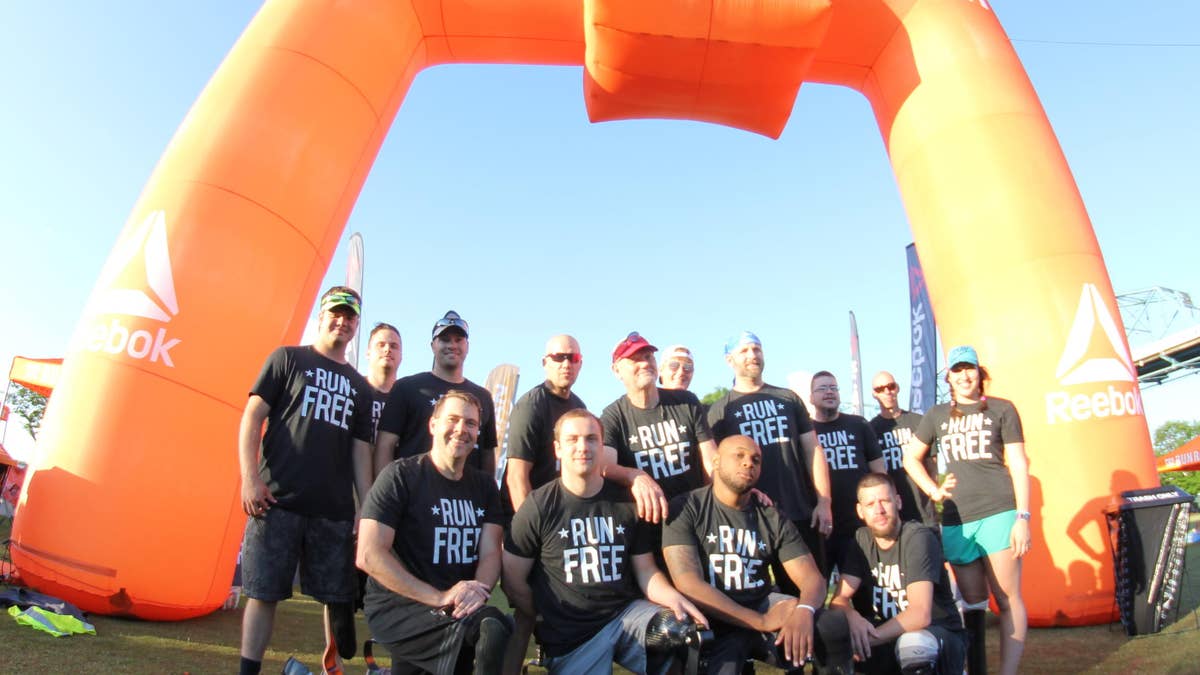
Team Run Free, made up of amputee runners, completed the Ragnar Relay Tennessee in 32 hours. (Image courtesy Amputee Blade Runners)
Mollyanne Rhodes, 19, was nervous about running the Ragnar Relay Tennessee, the 189.1-mile relay race from Chattanooga to Nashville. It wasn't because it was her first time participating in a relay race, where sleep and hygiene would be minimal. Nor was it because she'd be the lone female on her mostly-male team. Her biggest concern? "Breaking my leg; I'm notorious for that," she said. Luckily, her team van was stocked with extra running blades.
Extra equipment—spare blades, sockets, bolts—topped Team Run Free's packing list. The all-amputee group of runners became the first crew of its kind to complete a Ragnar Relay.
Members of Team Run Free, who ranged in age from 18 to 60 and hailed from seven states, were lead by team captain Ryan Fann. Fann lost his lower left leg when he was three years old after being hit by a truck. He became an all-star high school football player who eventually went on to compete in the 2004 Paralympics, where he won bronze in the 400 meters and gold as a part of the 4 x 400-meter relay.
GET MORE RUNNER'S WORLD: Sign up for the RW Daily newsletter
Fann wanted to encourage other amputees to lead active lifestyles, and so he became a certified prosthetist and founded Amputee Blade Runners (ABR), a Nashville-based nonprofit that provides running blades to in-need amputees to encourage them to be active. Running-specific prostheses aren’t covered by health insurance and can cost between $8,000 and $20,000. Since Fann created ABR in 2011, the organization has outfitted more than 75 amputees across 33 states with running blades. Thirteen of the 14 Team Run Free runners were ABR recipients.
More from Runner’s World: Watch: We Ran the Ragnar Relay
This was the third year ABR hosted a Ragnar team, but the past two years ABR fielded mixed teams of able-bodied and amputee runners. This was the first time an all-amputee team was assembled. Standard Ragnar teams have 12 runners, but the ABR team had two extra runners in case someone wouldn't be able to run all three legs. A few team members had only been running on blades for a few months, and it was uncertain if they could handle all three legs of the relay.
Team Run Free’s youngest runner, 18-year-old D.J. Vanderwerf, of Sweetwater, Tennesssee, was so determined to participate, he squeezed in his high-school graduation between relay shifts. After his first run, the three-sport athlete drove home to attend his graduation. Then he drove three hours to meet back up with his group so he could run the final leg of the relay, bringing the team across the finish in 32 hours.
John Van Haren, 44, of Nampa, Idaho, crushed his foot in a motocross racing accident in 2006. He started running with his wife after his 2010 amputation and regularly placed top five in his age-group in local races while running with an everyday prosthesis. He received his new running blade from ABR in February 2016. The Ragnar Relay was a big test for his new blade. "I didn’t want to miss out on an opportunity to run with my peers," said Van Haren, who covered roughly 16 miles total.
RELATED: Prep great meals (in less time!) with Meals on the Run.
Although Rhodes's big fear—her blade breaking—didn't happen, she didn't make it to the finish unscathed. Amputees didn't only worry about broken blades and loose bolts. The combination of sweat, friction, and hilly terrain can lead to sores, blisters, and split skin on their residual limbs. Two runners had to stop after their second runs due to bad cuts, sores, and blisters.
More from Runner’s World: 8 Tests of Your Overall Fitness
Rhodes, whose leg was amputated due to a congenital condition called veneous malformation, felt a blister forming on her residual limb during her first run. When she began her final run around 4:30 a.m., her blisters were so painful she had to take several walk breaks. Thoughts of her teammates, some of whom had sores and cuts on their legs far worse than hers, drove her to finish. “I’m really proud of myself," she said. "It was a horrible 5.6 miles, but it was the most rewarding 5.6 miles that I’ve ever run.”
More than anything, the race was an opportunity for the group of ABR athletes to come together, share their stories, and show what they’re capable of doing. “The ABR Ragnar experience was an incredible demonstration of how the appropriate equipment and motivation can allow people with limb loss the ability to be as great as they want to be,” Fann said.
More from Runner’s World: These Are Some of the Most Beautiful Runs Ever
“It’s such a cool moment to sit back and realize what we’ve done collectively as a team,” said Rhodes, who lives in Bentonville, Arkansas, and hopes to qualify for the 2020 Paralympics in swimming. “To have a whole team of amputees, it’s encouraging to the community. It shows that we can do whatever we want. It doesn’t matter what physical differences we have.”
